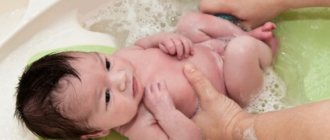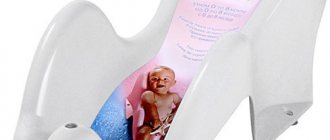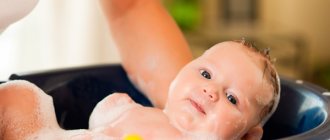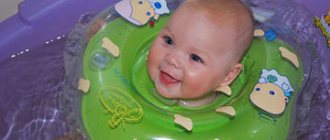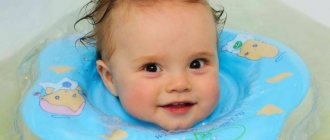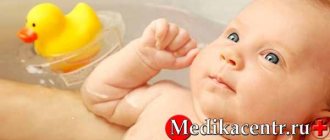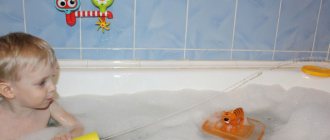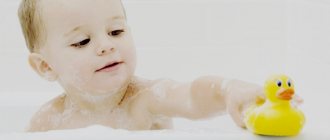Bathing in a large bath: pros and cons
Bathing is necessary for children. Its benefits are undeniable:
- the body is hardened - the child becomes stronger, healthier;
- energy is wasted - the baby dangles its legs, spins in the water, plays actively;
- the baby gets used to the water - he will have no fear of the sea or river;
- healthy sleep - warm water relaxes, active games make the child tired and sleep better;
- strengthening muscles, normalizing tone - water solves the problems of hyper- and hypotonicity of muscles.
The disadvantages include the baby's possible fear of water procedures. He can cry and break out. Parents have to be on guard - you can’t take your eyes off the baby and don’t move a step away. Parental carelessness can result in tragedy.
Chapter 5. Dousing
Baby: enjoys bathing. Mom: carefully turns the baby back up, lifting him out of the bath and saying: “Water will make our baby clean, healthy, strong.” At the same time, observing the child’s reaction to the dousing. Dad: carefully pours warm water +37°C over the baby in a thin stream from a jug. Wraps the baby in a clean towel and hands it to the mother.
When to give your newborn a bath
The opinion of pediatricians is ambiguous. Some believe that the procedures can be started after the navel falls off, others recommend starting ablutions upon arrival home from the maternity hospital.
American pediatricians, for example, advise mothers to wipe their newborns with a damp sponge, and when the umbilical cord stump falls off, to bathe their month-old baby in the bath.
It is also not forbidden to bathe the baby together with the parent, provided that the adult has proper hygiene and safety precautions are observed.
Chapter 7. Final: transition to sleep
Baby: quietly snoring in his crib Mom and dad: enjoying their child, sharing their impressions of the water procedure performed. Believe me, at this moment you will sincerely feel like the happiest parents.
Help During the bathing process, talk more with your baby, and not just with each other. At this moment, he develops sensory capabilities - visual and auditory reactions. Some parents play pleasant, calm music while bathing. This approach also has a beneficial effect on the child’s emotional status.
As you have seen, there are no particular difficulties in bathing a child. The main thing is not to get lost, and when you participate together, the fear quickly recedes. Remember, you are not the first and not the last who bathes your child on your own; after reading the article, you will become a “professor” in this matter.
Benefits of sharing a bath
Does your child not like water, but loves spending time with you? Get into the bath with him! Joint splashing has a number of advantages:
- The baby is not afraid to be in the water;
- A close emotional contact is established between you;
- You control the baby's movements;
- You have no physical tension - you don’t have to bend over your child or hold him, your back, arms and legs are relaxed.
It's great to soak in warm water with your mother if your baby lacks her attention during the day.
Please note: only same-sex parents can bathe together with their one-year-old daughter and son.
How to bathe your baby safely in the bath
- The child is under supervision. Don't leave him for a minute. The child sits confidently, strives to reach toys or the tap - especially don’t let your guard down. A baby who cannot sit must be held constantly. Remember: just a few centimeters of water is enough for a small child to choke;
- Prepare all care products in advance. Place them at arm's length from you;
- Measure the water temperature with a thermometer. The child will grow up, you will become more experienced - you will try with your elbow. The optimal temperature is 36.5 °C - 37 °C.
- There is no need to thoroughly bathe your newborn in the bathtub. Keep it in clean water or herbal decoction. A washcloth, shampoo and gel are unnecessary - a baby in the first month of life does not get dirty that much. Aggressive washing will wash away the lipid protection from the skin, it will become dry;
- There is no need to give your child a long bath. This can lead to dermatitis;
- Perform eye, ear and nose hygiene separately. Do not pour water on the baby’s face - he will get scared;
- There is no need to bathe your newborn in a stuffy bathtub. It shouldn't be hot in there. The optimal temperature is 24 °C;
- It is better to give your child a bath at the same time. 60 minutes after eating, 40 minutes before or 60 minutes before bedtime.
Chapter 3. Immersion in water
Baby: gradually sinks into the water, this is accompanied by a riot of sensations, often familiar, because he spent nine months in his mother’s belly in the same environment. Mom: in a clean diaper, lays the baby on a half-bent arm, the baby’s head is on the bend of the elbow. Slowly lowers him into a bath with prepared water, first the legs, then the buttocks, the back, gently wetting the baby’s chest. Lastly, wash your face. Dad: at this moment he is on hand, promptly giving mom everything she needs. Monitors the water temperature so as not to overcool the baby. Maintains a good mood during the procedure.
Getting ready to give a newborn a bath
You will need the following accessories and products during water procedures.
Towel. Large, soft, terry. Better - a children's one with a corner. You will wrap your baby in it after washing.
Cloth napkin. It is needed to blot your face.
Hygiene products. Cotton pads for washing, sticks or turundas for cleansing the nose and ears.
Detergents. Shower gel will be needed when the baby is 1 - 2 months old.
Skin products. Herbal decoction - add to water. Oil, powder, emollient cream - after the procedure.
Optional - circle, cap or slide for swimming. We'll talk about them later.
A bowl or cup of water is for the face. Do not wash it with bath water.
Clothes, diaper. Immediately after the water procedure, dress your baby.
Dr. Komarovsky about bathing a newborn
Bathing for a newborn child and his parents is a whole event (especially if it is the first time after the maternity hospital). Like any very responsible business, this process raises many questions: how and when to bathe, boil water or not, whether it is possible to add herbal decoctions and how often to do this, is it dangerous to get water into the ears, and so on. The famous pediatrician Evgeny Komarovsky, in his books and articles, has repeatedly talked about the basic rules and principles of organizing water procedures for a baby.
It is worth considering the most important points that you should know so that bathing brings pleasure and benefit to both the child and his parents.
How to bathe a baby in the bath: stages
Stage one. Prepare the necessary tools and accessories. Fill up with water. How much you need is up to you. For example, in Russia they prefer to bathe a one-month-old baby in a bath full of water. In the USA and Europe they believe that water 5 cm deep is enough - it is safer.
Stage two. Undress the baby. Place your right hand on your forearm with your back. If you are left-handed, switch hands.
Stage three. Place the child in the water. Support with your hand under the shoulder blades. The head rests on the forearm. Hold the baby tightly in the large bathtub.
Stage four. Start giving your newborn a bath. Talk to him kindly. Proceed smoothly and carefully.
Stage five. Complete the procedure. Place your hand under the baby's body and remove it from the water. Immediately wrap in a towel. Don’t rush to take it out of the bathroom - let it cool down in it. Dress the baby.
There is no need to bathe your baby in a large bath for more than 8 minutes. The first bath should not exceed 3 - 5 minutes. After a few months, your baby can flounder in the water for half an hour.
When to bathe a baby in a large bathtub depends on the child himself. Water relaxes him - bathe him before bed, excites him - after sleep.
Other recommendations
- do not use an old bathtub with indelible dirt and traces of mold to bathe your baby;
- prepare all bathing accessories in advance;
- do not leave your baby in the water unattended, even for a minute;
- Do not splash water in the baby's face - this may frighten the baby.
Bathing in a large bath is a good way to introduce your baby to swimming and exercise. If the process is properly organized, water procedures will bring many pleasant moments to children and their parents.
Baby washing sequence
It depends on the age of the baby. When washing babies several months old, the sequence is not important. The main thing is to carefully examine all the folds: groin, armpits, under the knees, on the bends of the elbows, buttocks, on the neck, the skin behind the ears. They need to be washed and blotted dry with a towel to avoid diaper rash.
Newborns clench their hands into fists - open them, wash the skin between the fingers. The same goes for your toes.
Hold the baby under the shoulder blades with one hand and wash with your free hand. Pour water over your tummy, chest, neck and folds.
Moisten your hair, try not to get water on your face or eyes. Do not wash your hair more than once a week.
Crawling babies get more dirty. Therefore, start bathing your baby in a large bathtub from top to bottom. First, wash your hair and gradually go down to your feet.
You need to bathe your child even more carefully when he starts walking, playing in the sandbox, or running outside. If necessary, use baby gels and shampoos.
What to bathe your baby in the bath
You can add sea salt without dyes and flavors and herbs to the water. They are used for hygienic and medicinal purposes. Therefore, before adding them to your baby’s bath, consult your pediatrician.
Here is the effect of natural supplements:
- Sea salt - strengthens muscles during hypotension, rickets;
- Calendula - for skin inflammation, dermatitis;
- Chamomile - cleanses the skin, relieves irritation, but dries;
- Sequence - acts similarly to chamomile, but does not dry out the skin. Eliminates dryness and redness during diathesis;
- Plantain - will help with skin rashes;
- Thyme - will relieve irritation and inflammation of the skin, swelling due to bruises.
To relax, it is good to bathe your child in a bath with a decoction of oregano, lavender, valerian or motherwort. These herbs strengthen and calm the nervous system, giving sweet dreams to the baby. Bathe your child in them in the evening, before going to bed.
Pediatricians advise mothers to alternate regular baths with herbal ones.
Herbal decoctions, potassium permanganate: are they really necessary?
In the first months of life, it has long been customary to add antiseptics to bathing water. Potassium permanganate, string and chamomile are classics.
These herbs supposedly disinfect and calm the baby. But, as Dr. Komarovsky said, bathing in herbs calms the mother, and not if the mother is calm, the child is calm. When a baby has neurological disorders, no amount of bathing in herbs will calm him down.
Let's move on to potassium permanganate. In order for it to have an antiseptic and disinfecting effect, it is necessary to make the water not light pink, but bright pink. But such a concentration of potassium permanganate in water can lead to burns to the baby’s mucous membranes. Light pink water with potassium permanganate will only calm the mother down, but will not disinfect the water.
How to bathe a child in a bath: methods
There are several options: swimming with a circle, with a slide and swimming. Let's consider their advantages and technique of the procedure.
Swimming with a circle
The circle is similar to the usual one for swimming in the sea. It is put on the baby’s neck and holds it on the surface of the water. The device is needed more by parents than by children: it reduces the load on the back and hands of adults. With it, mom and dad don’t need to stand bent over the child.
Opinions differ regarding the benefits and harmlessness of the circle for children. Many osteopaths and traumatologists have a very negative attitude: the circle can cause injury to the cervical spine. It is still very weak in a baby - the risk is great.
How to bathe a baby in a large tub with a circle.
First, use for a baby at least 3 months old.
Secondly, the duration of bathing is a maximum of 10 minutes.
Third, swim only on your back.
Fourth, take a full bath of water.
Fifth, be guided by the child’s reaction. If he doesn't like it, take it off.
Sixth - do not use if there are contraindications. These include: dermatological problems, high intracranial pressure, injuries (fractures, dislocations) that interfere with putting on the circle.
There is an alternative to a circle - a foam cap. It is safer for the neck than a circle. You will have to hold the baby - for this purpose the hats are equipped with long ribbons. It is possible that the baby may go under the water with its face - control the position of its head.
Swimming with a slide
Another device to make life easier for parents. There are different types of slides: in the form of a hammock, plastic, fabric. More often they buy plastic ones - they are more practical.
The slide allows one person to carry out the water procedure: pick up the gel, put the baby on, and wash off the foam. Thanks to the device, the child does not need to be held.
How to bathe a baby in a large bathtub on a slide.
First, securely secure it in the bathroom. It must be sustainable.
Secondly, fill the bathroom with water. It should cover half the slide. Wait until it warms up. You can put a film on it.
Thirdly, the water should reach the baby’s neck - no higher. Otherwise, he may take a sip of water and get scared. If the water reaches chest level, this is not enough - the child will freeze.
Fourthly, do not leave the baby unattended for a second!
Swimming without a slide or lap
Infant swimming has many advantages.
It forms in the baby a positive attitude towards water and a normal reaction to temperature changes.
It strengthens the body - children with good immunity get sick less.
Promotes harmonious physical development - strengthens muscles, shapes posture, prevents scoliosis in the future.
Babies who swam in the bathtub from the first weeks of life begin to crawl, sit, stand, walk, and run earlier. They are physically stronger.
Swimming helps increase hemoglobin levels. This is due to the release of red blood cells during exercise. Blood circulation improves, blood pressure normalizes, and the lungs work better.
Swimming is an excellent prevention of runny nose and allergies in newborns. Swimming has a positive effect on the baby's nervous system: he sleeps more soundly and is calm.
A close emotional connection is established between mother and baby through physical contact while swimming.
Safe swimming rules
The optimal age is 3 - 4 weeks. By this time, the baby will gain weight, adapt to new living conditions, and become a little stronger. His umbilical wound will heal. Mom will get used to the little person and become more confident in communicating with him.
We are preparing a bath. First you need to wash it - with soda or laundry soap.
We collect water. Conduct your first workouts in warm water - 35 °C. Over the next 2-3 months, the temperature can be reduced to 32 °C, but not lower.
Let's keep an eye on the little one. They put him in water and he cries - the water is cold, add warm. He whines, and then actively works with his legs and arms - you guessed it with the temperature. Relaxed and doing nothing - add cool water.
We harden it naturally. During the procedure, the water cools down. Do not add warm water - let the baby flounder in the water. This is a double benefit: it strengthens muscles and hardens.
Making life easier for mom
You can increase your baby's bath time by taking care of the mother's back. To do this, you just need to give the child the opportunity to bathe himself. Fortunately, the choice of additional devices is extensive:
- swimming circle.
Bathing with a circle around the neck allows the child to splash in the water without mother's help from the first days. It is fixed on the baby’s neck in a certain position: the chin must be in a specially designated recess. As a rule, the circle has two inflatable compartments for greater safety of the child. There may be bells inside that vibrate pleasantly when moving. Two people should put the circle around the child’s neck and not above the water: one holds the child upright, the other puts the circle around the neck; - The slide will help mom in both large and small baths. There are the following types of slides: plastic slides. Suitable for children from birth and protects the child from accidental falls;
- fabric slide. Soft, comfortable;
- slide-hammock. Great for small baths. It is fixed by the sides, and the baby, with minimal support from the parents, splashes on its base;
A baby at this age is very unstable and at the same time inquisitive. Such chairs will support him in small endeavors and will not allow him to fall in the bath. There are several varieties of them:
- classic with suction cups;
